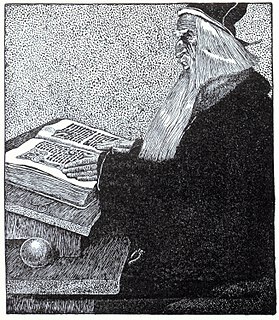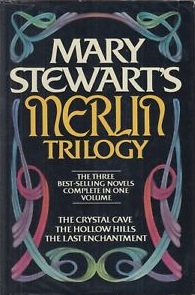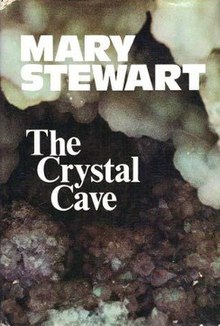
Ambrosius Aurelianus was a war leader of the Romano-British who won an important battle against the Anglo-Saxons in the 5th century, according to Gildas. He also appeared independently in the legends of the Britons, beginning with the 9th-century Historia Brittonum. Eventually, he was transformed by Geoffrey of Monmouth into the uncle of King Arthur, the brother of Arthur's father Uther Pendragon, as a ruler who precedes and predeceases them both. He also appears as a young prophet who meets the tyrant Vortigern; in this guise, he was later transformed into the wizard Merlin.

Merlin is a mythical figure prominently featured in the legend of King Arthur and best known as an enchanter or wizard, among his various other roles. His usual depiction, based on an amalgamation of historic and legendary figures, was introduced by the 12th-century British author Geoffrey of Monmouth. It is believed that Geoffrey combined earlier tales of Myrddin and Ambrosius, two legendary Briton prophets with no connection to Arthur, to form the composite figure called Merlinus Ambrosius . Geoffrey's rendering of the character became immediately popular, especially in Wales. Later writers in France and elsewhere expanded the account to produce a fuller image, creating one of the most important figures in the imagination and literature of the Middle Ages.

Uther Pendragon, also known as King Uther, is a legendary king of sub-Roman Britain and the father of King Arthur. A few minor references to Uther appear in Old Welsh poems, but his biography was first written down in the 12th century by Geoffrey of Monmouth in his Historia Regum Britanniae, and Geoffrey's account of the character was used in most later versions. He is a fairly ambiguous individual throughout the literature, but is described as a strong king and a defender of his people.

Dinas Emrys is a rocky and wooded hillock near Beddgelert in Gwynedd, north-west Wales. Rising some 76 m (250 ft) above the floor of the Glaslyn river valley, it overlooks the southern end of Llyn Dinas in Snowdonia.

In the Matter of Britain, Igraine is the mother of King Arthur. Igraine is also known in Latin as Igerna, in Welsh as Eigr, in French as Ygraine, in Le Morte d'Arthur as Ygrayne—often modernised as Igraine or Igreine—and in Parzival as Arnive. She becomes the wife of Uther Pendragon, after the death of her first husband, Gorlois.

The Mists of Avalon is a 1983 historical fantasy novel by American writer Marion Zimmer Bradley, in which the author relates the Arthurian legends from the perspective of the female characters. The book follows the trajectory of Morgaine, a priestess fighting to save her Celtic religion in a country where Christianity threatens to destroy the pagan way of life. The epic is focused on the lives of Morgaine, Gwenhwyfar (Guinevere), Viviane, Morgause, Igraine and other women of the Arthurian legend.

Myrddin Wyllt is a figure in medieval Welsh legend. In Middle Welsh poetry he is accounted a chief bard, the speaker of several poems in The Black Book of Carmarthen and The Red Book of Hergest. He is called Wyllt—"the Wild"—by Elis Gruffydd, and elsewhere Myrddin Emrys ("Ambrosius"), Merlinus Caledonensis or Merlin Sylvestris("of the woods"). Myrddin Wylt is born in 540 CE.

In Arthurian legend, Gorlois of Tintagel, Duke of Cornwall, is the first husband of Igraine, whose second husband is Uther Pendragon. Gorlois's name first appears in Geoffrey of Monmouth's Historia Regum Britanniae. A vassal of Ambrosius Aurelianus, his arrival at the Battle of Kaerconan ensures the defeat of Hengist. In Wace's Roman de Brut, when Hengist's son Octa and his cousin Ossa rebel, Gorlois helps Uther defeat them at York.
The Pendragon Cycle is a series of historical fantasy books based on Arthurian legend, written by Stephen R. Lawhead. The cycle was originally planned as a four-book series, but the original publisher opted to stop after the first three books, resulting in an abrupt ending to Arthur and the existence of many unexplored stories and plotlines. Lawhead moved to a new publisher a few years later. It was decided to expand on the trilogy by finishing the series, and two additional books were planned. The later book Avalon is not considered to be a true addition to the cycle but rather a "related semi-sequel" to round out the "Once and Future King" aspect of the legend.

Merlin is a two-part 1998 television miniseries which originally aired on NBC that retells the legend of King Arthur from the perspective of the wizard Merlin.
This is a bibliography of works about King Arthur, his family, his friends or his enemies. This bibliography includes works that are notable or are by notable authors.

The Hollow Hills is a novel by Mary Stewart. It is the second in a trilogy of novels covering the Arthurian Legends. This book is preceded by The Crystal Cave and succeeded by The Last Enchantment. The Hollow Hills was published in 1973.

King Arthur's family grew throughout the centuries with King Arthur's legend. Many of the legendary members of this mythical king's family became leading characters of mythical tales in their own right.
The mythical wizard Merlin is featured as a character in numerous works of fiction, especially those based on Arthurian legends.

Mary Stewart's Merlin Trilogy is an omnibus edition of the first three novels in Mary Stewart's Arthurian Saga: The Crystal Cave (1970), The Hollow Hills (1973), and The Last Enchantment (1979). The omnibus was published in 1980 by William Morrow and Company. In 1983, Stewart published a fourth instalment in the series: The Wicked Day.
Merlin and the Dragons is a 1991 animated film adapted from a story by Jane Yolen and illustrations by Alan Lee. It was directed by Dennis Woodyard and Hu Yihong and includes a musical score by composer Michel Rubini. The production is a retelling of the Arthurian legend, with Merlin the magician, based on material from Nennius and Geoffrey of Monmouth. Yolen is a prolific author of Arthurian-themed texts, and this production continues her series of retellings of the Merlin story. The half-hour film is narrated and voiced by Kevin Kline and was originally broadcast as an episode of the PBS program Long Ago and Far Away, which first aired on November 9, 1991.

The Sons of Avalon Saga is a series of Arthurian Legend novels, by American novelist, Dee Marie. The first book in the series, Sons of Avalon, Merlin’s Prophecy, begins with the birth of Merlin, and ends with the conception of King Arthur. Future books in the series explore the birth and life of King Arthur and his court.
Of Arthour and of Merlin, or Arthur and Merlin, is an anonymous Middle English verse romance giving an account of the reigns of Vortigern and Uther Pendragon and the early years of King Arthur's reign, in which the magician Merlin plays a large part. It can claim to be the earliest English Arthurian romance. It exists in two recensions: the first, of nearly 10,000 lines, dates from the second half of the 13th century, and the much-abridged second recension, of about 2000 lines, from the 15th century. The first recension breaks off somewhat inconclusively, and many scholars believe this romance was never completed. Arthur and Merlin's main source is the Estoire de Merlin, a French prose romance.













